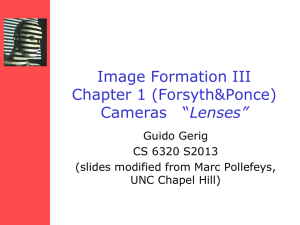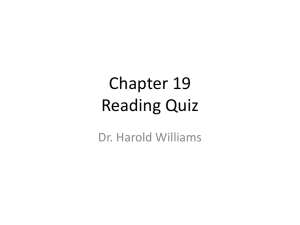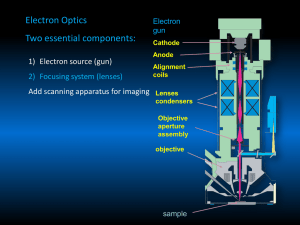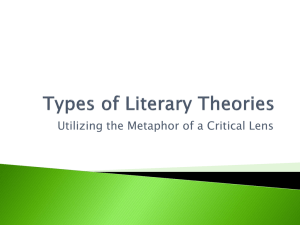Electron Optics
advertisement
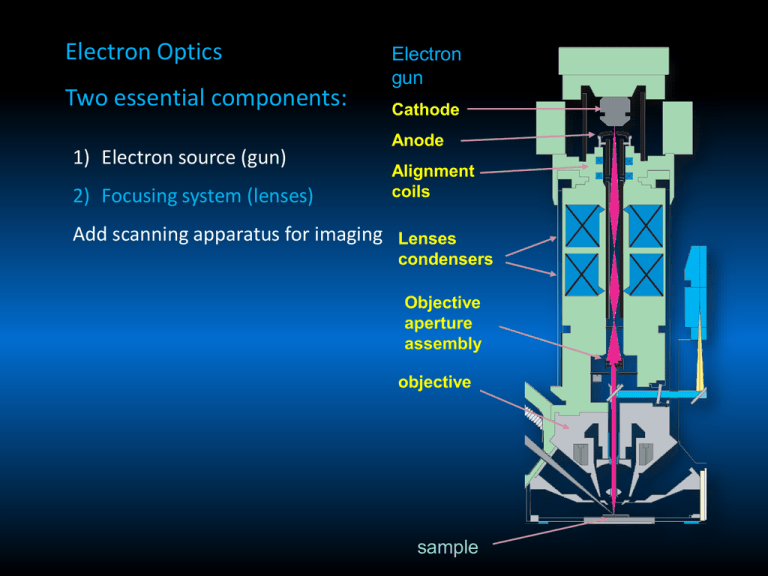
Electron Optics Two essential components: 1) Electron source (gun) 2) Focusing system (lenses) Add scanning apparatus for imaging Electron gun Cathode Anode Alignment coils Lenses condensers Objective aperture assembly objective sample Electron Lenses Principle of electromagnetic focusing Interaction of electromagnetic field on moving charge (electron) Vector equation → → → F = -e(VxB) Magnitude of F will be F = -eVBsinθ where θ is the smaller of two angles between V and B Direction of F determined by “right hand rule” F = Force on electron V = electron velocity B = Magnetic field strength (rotationally symmetric) e = charge of electron Axially symmetric electromagnetic lens Fe shielding to prevent flux leakage from solenoid Lens strength: intensity of field in gaps proportional to (NxI) N = # turns of solenoid winding I = current flowing through windings Focal Length (f): Point on Z axis where initially parallel rays cross the axis after passing through the lens HIGHER LENS STRENGTH = SHORTER FOCAL LENGTH B = vector parallel to field Upper polepiece Br = radial component of field (vector perpendicular to axis) Bz = axial component of field (vector High lens parallel to axis) strength = short B varies depending on position in lens focal length Results: Lower polepiece Force strongest in the center of the gap Actual electron paths spiral through lens Low lens strength = long focal length Usually two-stage condenser system Purpose: 1) Further demagnification of the gun crossover image 2) Control amount of beam entering objective major effect on beam current at sample High Lens strength Small crossover image Less current entering the objective Low Lens strength Large crossover image More current entering the objective Electron gun Condenser f (high condenser lens strength) f (low condenser lens strength) Objective High condenser strength Short focal length Low condenser strength Sample Long focal length Large divergence angle Small divergence angle Low current into objective High current into objective Objective lens Purpose: control the size and shape of the final beam spot Considerations: Produce small beam diameter Magnetic field must not hinder detector system from collecting low eV electrons Must allow clear path from sample to detectors Bore must be large Contain scan coils and Stigmators Beam-limiting apertures Aberrations usually increase with focal length – minimize aberrations For quantitative analysis long focal length = long working distance high takeoff angle and low absorption For objective Increase demagnification by increasing lens strength to produce small spot size → Short working distance due to short focal length → Short depth of field Objective lens, therefore, Controls image focus = beam size Pinhole lens Objective lens design Immersion lens Snorkel lens Electron gun Condenser High objective strength Low objective strength Short focal length Small divergence angle Large divergence angle Long working distance Short working distance Large depth-of-field Short depth-of-field Low resolution long focal length High resolution f (high objective lens strength) Objective = short working distance f (low objective lens strength) = long Working distance Sample Effective beam diameter Current in final beam spot is a function of: 1) Condenser lens strength 2) Objective aperture size Objective aperture affects: 1) Current reaching sample 2) Beam size passing through objective 3) Depth of field Tradeoff: Best image resolution with smallest spot size (smaller aperture) Direct cutting of current compromises signal produced as current reduced in final spot Short Long working working distance distance Depth of field Insert smaller objective aperture to improve D Sample surface D Plane of focus Pixel size Region of image in effective focus Beam current regulation Feedback to condensers Objective aperture assembly = beam regulating assembly Sense current drift on aperture and adjust condenser lens strength to compensate Production of minimum beam size Magnification: S0 Electron gun Mc = S0/Si = magnification of condenser S0 = distance from gun crossover to lens gap Condenser Si = distance from gap to where imaged S1 (related to focal length) Diameter of beam after passing through condenser Objective di = d0/Mc Sample S0 is constant, so Increase condenser current → decrease in focal length and increase in demagnification (smaller crossover diameter) Note that divergence angle also increases so less current enters objective For objective: Increase demagnification to produce small beam diameter, results in: - short working distance - short depth of field Final beam size: df = d0 / (McMobj) Current in final beam is a function of: - condenser lens strength - objective aperture size Minimum beam size (and highest resolution) achieved by increasing lens strength – sacrifice current (and signal / noise) Quality of final beam at the sample will be affected by: - lens aberrations - vacuum quality - sample effects Lens aberrations Spherical Chromatic Diffraction Astigmatism Coma Electrons moving in trajectories further from optic axis are focused more strongly than those near the axis Causes image enlargement (disk = ds) Diameter of ds = ½ Cs α3 Cs = spherical aberration coefficient α = angle of outer ray through lens Cs minimized in short focal length lenses (e.g., immersion) For pinhole lenses, can decrease spherical aberration by decreasing α using aperture Lens aberrations Spherical Chromatic Diffraction Astigmatism Coma If energies of electrons passing through the lens differ, they will follow different ray paths Always some spread in initial electron energies as leave cathode W ~ 2 eV LaB6 ~ 1 eV FE ~ 0.2 to 0.5 eV Minimize by decrease in α Diameter of dc = CCα (ΔE / E0) Cc = chromatic aberration coefficient α = convergence angle Directly related to focal length Much less significant at high E0 Lens aberrations Spherical Chromatic Diffraction Astigmatism Coma Wave nature of electrons Diameter of dd = 0.61 λ / α λelectrons = 1.24 / (E0)1/2 Larger divergence angle (α) = smaller contribution of dd Spherical aberration disk ds and aperture diffraction disk dd vs. aperture angle Lens aberrations Spherical Chromatic Diffraction Astigmatism Coma Magnetic lenses have imperfect symmetry Enlarges beam diameter and changes shape Use stigmators in objective lens supplies weak correcting field typically use octupole arrangement Lens aberrations Spherical Chromatic Diffraction Astigmatism Coma Different focal lengths of electron paths with different incidence angles Generally eliminated by proper lens alignment Aberrations most significant in objective Final probe size = quadrature sum of disk diameters… dp = (dg2 + ds2 + dd2 + dc2)1/2 dg = gaussian probe size Importance: At 30 kV, tungsten filament imax = 1.64 x 10-12 A diameter dd = 1.4 nm ds = 2.5 nm chromatic aberration especially significant for W sources where ΔE ~ 2-3 eV Increase effective diameter 1) 30 kV dp 5nm → 6.5nm 2) 15 kV → 9.5 nm lower energy spread will make a big difference… Elstar electron column Schottky - UC, hot swap gun Key design elements: • Large travel/tilt stage compatible • “DualBeam” SEM-FIB • Minimum lens aberrations • Automated aperture selection • Default small beam current • Small gun apertures • High current for analytics >20 nA • Thermal & environmental stability • Constant power lenses • Double magnetic shielding • Electrostatic scanning Double magnetic shielding Fast beam blanker CP Electrostatic scanning 2- mode objective lens with with field -field-free free and and coils immersion capability New TLD design CP vCD Beam at HV Beam at landing V Beam deceleration I1 I2 CP Sample Bias Magellan XHR SEM: three beam modes available extractor, 2 apertures SchottkyFEG segmented gun lens aperture and slit deflector Standard High current Monochromated (UC) Performance improvement with monochromator 25-75% edge resolution [nm] 4.5 total, UC off Beam voltage 1 kV chromatic and total, UC on The spherical aberration contributions dominate at Cc, UC off high aperture angles… Cc, UC on diffraction Cs 4 3.5 3 2.5 2 Spherical 1.5 Diffraction effects dominate everything at low aperture angles… 1 Chromatic More current (better S/N) Improved resolution 0.5 0 0 10 20 alpha [mrad] 30 UC allows larger α therefore lower diffraction (dd) 40 Magellan: Resolution improvement UC off and on UC off • • 1 kV, no beam deceleration 256 nm HFW in both cases UC on Beam deceleration: enhancing resolution and contrast Beam What is beam deceleration? New optics mode enabling high resolution imaging and high surface sensitivity at very low kV BD specifications: • Landing energy range: 30 keV down to 50 eV • The deceleration (Bias) can be continuously adjusted by the user Benefits: • Enhances the resolution • Provides additional contrast options • Greatest benefit at 2kV and below 2-mode final lens TLD HV vCD Landing V Sample Bias If Bias=0 (no BD): Landing V = HV Extending low kV resolution via UC and BD 50 V 25-75% edge resolution [nm] 3.5 3 BD on, UC on BD off, UC on BD off, UC off 2.5 2 1.5 1 0.5 0 10 100 1000 10000 Landing voltage [Volt] 100000 50 V with 1 kV beam deceleration 850 nm HFW Practical considerations: Must optimize: Instrument alignment (gun, lenses, apertures) Minimum vibration Minimum stray fields Specimen contamination Clean apertures Then go for minimum spot size if resolution is the goal However, ultimate resolution depends on the detected signal, a function of: Minimum spot size AND Emission volume of signal… beam-specimen interactions Electron gun Condenser Objective Sample



